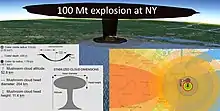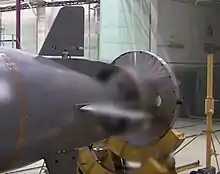Status-6 Oceanic Multipurpose System
The Poseidon (Russian: Посейдон, "Poseidon", NATO reporting name Kanyon), previously known by Russian codename Status-6 (Russian: Статус-6), is an autonomous, nuclear-powered, and nuclear-armed unmanned underwater vehicle under development by Rubin Design Bureau, capable of delivering both conventional and nuclear payloads.
| Poseidon | |
|---|---|
| Type | Nuclear-powered, nuclear-armed UUV |
| Place of origin | Russia |
| Service history | |
| Used by | Russia |
| Specifications | |
| Blast yield | 2–100 Mt[1][2] |
Launch platform | Submarine |
| External video | |
|---|---|
The Poseidon is one of the six new Russian strategic weapons announced by Russian President Vladimir Putin on 1 March 2018.[3]
History
The first public appearance of Poseidon dates back to September 2015 and cites Pentagon sources.[4]
On 10 November 2015, a page of a document that contained information about a secret "oceanic multi-purpose system" called "Status-6" was "accidentally" revealed by Russian NTV television channel. The leak happened during Russian President Vladimir Putin's speech denouncing American plans concerning defensive missile technology.[5] Speculation arose as to whether this was a warning signal or disinformation intended to mislead foreign intelligence services.[6] The CIA has concluded the leak was intentional.[5]
According to Pentagon, Russia conducted the first test-launch of Poseidon on 27 November 2016, using the B-90 Sarov special purpose submarine. The test was reportedly carried out in the Arctic Ocean.[7][8]
In early 2018, Pentagon's Nuclear Posture Review publicly acknowledged development of Russia's "new intercontinental, nuclear armed, nuclear-powered, undersea autonomous torpedo".[9][10][11][12]
In March 2018, the system was officially named "Poseidon", following a public vote.[13]
In January 2019, Russian Navy announced plans to procure at least 30 Poseidon unmanned underwater vehicles, deployed on four submarines, two of which would serve the Russian Northern Fleet and two the Pacific Fleet.[14]
On 2 February 2019, Russian President Vladimir Putin announced completion of the key stage of trials of Poseidon.[15]
On 20 February 2019, the Russian Defence Ministry released a video, showing a Poseidon being test-launched by a B-90 Sarov special purpose submarine.
Design

Overview

The Poseidon is intended as an asymmetric counter to U.S. missile defense systems, such as anti-ballistic missiles, railguns, or laser weapons, ensuring Russia's capability to overcome such systems.[16][17][18]
The Poseidon warhead can contaminate a large area with radiation. According to NukeMap simulations, the size of the radioactive area will be about 1700×300 kilometers.[19][20] For this purpose, the Poseidon is believed to be equipped with a toxic cobalt bomb, containing cobalt-60.[21][22] Poseidon appears to be a deterrent weapon of last resort.[23][24] An aircraft carrier battle group would have reduced chances of defending itself against it. The drone could detonate its very large warhead at standoff range, and anti-submarine warfare units would have very little time to react because of the speed at which it travels.[25]
Specifications

The Poseidon appears to be a torpedo-shaped robotic mini-submarine which can travel at speeds of 185 km/h (100 kn).[23][24][26] More recent information suggests a top speed of 100 km/h (54 kn), with a range of 10,000 km (5,400 nmi; 6,200 mi) and a depth maximum of 1,000 m (3,300 ft).[27]
Typical depth of the drone may be about 50–100 meters for increased stealth features in low-speed stealth mode. Low depth in stealth mode is preferred because sound waves move to ocean floor and reduce radius of detection. Submarines use the same strategy in silent running mode.[28]
It is 1.6–2 metres in diameter, and 24 metres long.[29] The warhead shown in the leaked figure is a cylinder 1.5 metres in diameter by 4 metres in length, giving a volume of 7 cubic meters. Comparing this to the volumes of other large thermonuclear bombs, the 1961 Soviet-era Tsar Bomba itself measured 8 metres long by 2.1 metres in diameter, indicates that the yield is at least several tens of megatons, generally consistent with early reports of 100 megatons. Some reports suggest the yield of the Poseidon's warhead is as low as 2 Mt.[1]
Powerplant
The National Interest compiled several unclassified defense sources from General Electric experts about the similar 601B project[31][32][33] and they predicted low weight and compact gas-cooled nuclear reactor in the drone.[34] Russian submarine designers say that a low-power reactor is preferred for Poseidon because a smaller reactor is less noisy.[28]
Stealth technology

The development includes also use of stealth technology, to elude acoustic tracking devices.[24][28][35] Poseidon uses a silent running strategy like other submarines. Its main stealth feature is its very low speed before it reaches the target area. Its high-speed mode activates upon reaching a short finish range (2–3 kilometers), when the probability of detection of the drone is considerably higher. It could travel for weeks toward enemy port cities, reaching high-speed only in the final stage.[34]
Russian designers estimated the radius of detection of the drone will be about 2–3 km (1.2–1.9 mi) for 55 km/h (34 mph).[28] A second important stealth feature of the drone is the special design of the pump-jet for clearance of the drone's acoustic signature to imitate the noise of civil ships.[28]
| Speed of the drone (km/h) | Detection range (km) |
|---|---|
| 37 | 1.7 |
| 55 | 3 |
| 74 | 29 |
| 93 | 43 |
A U.S. intelligence officer told CNBC that the Poseidon is difficult to detect and difficult to target in stealth mode.[36]
Supercavitation
The Poseidon is a family of drones rather than a single type, with some Poseidons designed only for destroying coastal cities and thus relying on "stealth" capabilities rather than on high speed,[28] and other ones primarily designed to attack carrier battle groups,[25] where the later ones may use the supercavitation, like the VA-111 Shkval torpedo, to be able to gain extremely high speed in attack mode (more than 200 km/h (120 mph)).[37][38] However, supercavitation devices have not been observed on the available footage of Poseidon.[39] Pentagon estimates maximum speed of the Poseidon about 56 kn (104 km/h; 64 mph) without the supercavitation option.[40]
Launch platforms
Two vessels that are speculated to carry the Poseidon, the Project 09852 Oscar-class submarine Belgorod and the Project 09851 Khabarovsk submarines, are new boats launched in 2019 and 2020, respectively.[24][29][41][42] Oscar-class submarines could carry four Poseidon torpedoes at the same time for a total yield of up to 400 megatonnes.[43]
According to some reports, the Poseidon may also have a seabed or mobile sites launch option. In the seabed option, known as Skif (Скиф), Poseidon can wait on the sea floor in a special container for as long as necessary. It is known that the Russian auxiliary vessel ZVEZDOCHKA 600 (Project 20180) with ice-breaking capability is being used for testing of the Poseidon drones, thus it's believed the ship can be also used as the platform for deploying and retrieving a seabed version of the drone.[44] The seabed launch option was patented (RU 2135929 patent) by the Poseidon designer Alexander Shalnev.[45]
Reactions
Following the Russian President Vladimir Putin's statement in March 2018, in which he referenced to the Poseidon as a weapon that could hit U.S. port cities, U.S. Defense Secretary James Mattis stated Russia already has the capability to hit U.S. port cities with missiles, and said that Poseidon "does not change at all the strategic balance".[46]
See also
- 9M730 Burevestnik - a Russian nuclear-powered cruise missile
References
- "Video Suggests Russia's Poseidon Nuclear-Powered Drone Has A Seabed-Launched Version". Forbes. 17 November 2019. Retrieved 27 November 2019.
- "The Truth Behind Russia's 'Apocalypse Torpedo'". Popular Mechanics. 18 January 2019. Retrieved 27 November 2019.
- "Russia Releases Videos Offering An Unprecedented Look At Its Six New Super Weapons - The Drive".
- "Russia Building Nuclear-Armed Drone Submarine". The Washington Free Beacon. Sep 8, 2015. Archived from the original on November 20, 2015.
- "Russia reveals giant nuclear torpedo in state TV 'leak'". bbc.com. 12 November 2015. Retrieved 24 February 2019.
- "CIA: Leak of Nuclear-Armed Drone Sub Was Intentional". The Washington Free Beacon. November 19, 2015. Archived from the original on 2015-11-20.
- "Did Russia test doomsday weapon in Arctic waters?". The Independent Barents Observer.
- Pentagon Confirms Russia Has a Submarine Nuke Delivery Drone Popular Mechanics. By Kyle Mizokami, Dec 8, 2016.
- "Russia has underwater nuclear drones, newly leaked Pentagon documents reveal". 14 January 2018. Retrieved 21 January 2018.
Russia is also developing at least two new intercontinental range systems, a hypersonic glide vehicle and a new intercontinental, nuclear-armed undersea autonomous torpedo.
- "US says Russia 'developing' undersea nuclear-armed torpedo". CNN. 2018. Retrieved 8 February 2018.
- "Pentagon Confirms Existence of Russian Doomsday Torpedo". Popular Mechanics. 2018-01-16. Retrieved 2018-01-21.
- Farley, Robert. "Russia's Status-6: The Ultimate Nuclear Weapon or an Old Idea That Won't Die?". The National Interest. Retrieved 21 January 2018.
- "New Russian weapons named". Jane's 360. 23 March 2018. Retrieved 5 April 2018.
- "Russian Navy to put over 30 Poseidon strategic underwater drones on combat duty - source". TASS (in Russian). Retrieved 2019-03-24.
- "Key stage of Poseidon underwater drone trials completed, says Putin". TASS. 2 February 2019. Retrieved 24 February 2019.
- "A bungled leak about Russia's nuke plan or a leak to show its military might?". Mirror. Retrieved 2015-11-11.
- "Russian drone submarine would threaten U.S. coast; nuclear vessel in development". The Washington Times. Retrieved 2015-11-12.
- "Эксперт: создание РФ океанской системы "Статус-6" обесценит ПРО США". ТАСС. Retrieved 2015-11-12.
- Menn, Håkon Bonafede Vi. "Russlands skrekkvåpen er så farlig at det aldri er testet". Side3 (in Norwegian). Retrieved 2019-03-25.
- "Что может сделать с Америкой "Посейдон"". SV pressa (in Russian). 2018-05-15. Retrieved 2019-03-25.
- "Russia reveals giant nuclear torpedo in state TV 'leak'". BBC. 12 November 2015. Retrieved 24 February 2019.
- "Россия "засветила" новое супероружие". Российская газета (in Russian). Retrieved 2019-03-24.
- Steven Pifer S. Russia's perhaps-not-real super torpedo. Brookings Institution. November 18, 2015.
- Oliphant R. Secret Russian radioactive doomsday torpedo leaked on television. Telegraph. 13 November 2015
- Pentagon Confirms Russia Has a Submarine Nuke Delivery Drone Popular Mechanics. Kyle Mizokami, Dec 8, 2016.
- Lockie, Alex (24 December 2016). "Trump questions the US's nuclear arsenal: Here's how the US's nukes compare to Russia's". Retrieved 18 January 2018.
- "Pentagon Confirms Russia's Thermonuclear Submarine Bomb Is Real". 8 December 2016. Retrieved 18 January 2018.
- "О возможностях гидроакустического обнаружения суперторпед системы "Статус-6" - ВПК.name". vpk.name. Retrieved 2015-12-12.
- Insinna, Valerie (12 January 2018). "Russia's nuclear underwater drone is real and in the Nuclear Posture Review". DefenseNews. Gannett. Retrieved 3 February 2018.
- Commosar, S; CALVERT; HILLMAN; CHASE; NASH; NICOLL; OSGOOD; SEMPLE; THOME (1962). CULVER (ed.). APEX-910. APPLICATION STUDIES. http://leehite.org/anp/documents.htm: General Electric. p. 139.
- Axe, David (2013-08-06). "This Nuclear Outboard Motor Was a Really Terrible Idea". Medium. Retrieved 2019-03-24.
- "601B project". up-ship.com. Retrieved 2019-03-26.
- Steve Weintz (2018-07-07). "Why Russia's Status-6 Torpedo Is Really a 100-Megaton Cruise Missile". The National Interest. Retrieved 2019-02-26.
- "Есть ли в России современное гидроакустическое вооружение? - ВПК.name". vpk.name. Retrieved 2015-12-12.
- Macias, Amanda (2019-03-25). "Russia's nuclear-armed underwater drone may be ready for war in 2027". www.cnbc.com. Retrieved 2019-03-26.
- "Источник: стратегический подводный беспилотник "Посейдон" получит скорость более 200 км/ч". ТАСС. Retrieved 2019-03-24.
- Hambling, David (2019-01-18). "Who's Afraid of Russia's Apocalypse Torpedo?". Popular Mechanics. Retrieved 2019-03-24.
- "H I Sutton - Covert Shores". www.hisutton.com. Retrieved 2019-03-24.
- "Pentagon documents confirm Russia is developing a nuclear submersible doomsday weapon". NEWSREP. 2018-01-18. Retrieved 2019-03-24.
- Franz-Stefan Gady. "Revealed: Russia's Top Secret Nuclear Torpedo". The Diplomat. Retrieved 18 January 2018.
- Russian Mystery Submarine Likely Deployment Vehicle for New Nuclear Torpedo. USNI News.
- PM, Carlos Ballesteros On 1/14/18 at 1:27 (2018-01-14). "Russia has underwater nuclear drones, newly leaked Pentagon documents reveal". Newsweek. Retrieved 2019-02-13.
- "H I Sutton - Covert Shores". www.hisutton.com. Retrieved 2019-03-24.
- "Глубочайшая тайна России | Еженедельник "Военно-промышленный курьер"". vpk-news.ru. Retrieved 2019-03-24.
- "Russia says it has successfully launched powerful new missile". the Guardian. 11 March 2018. Retrieved 12 March 2018.
External links
 Media related to Status-6 at Wikimedia Commons
Media related to Status-6 at Wikimedia Commons